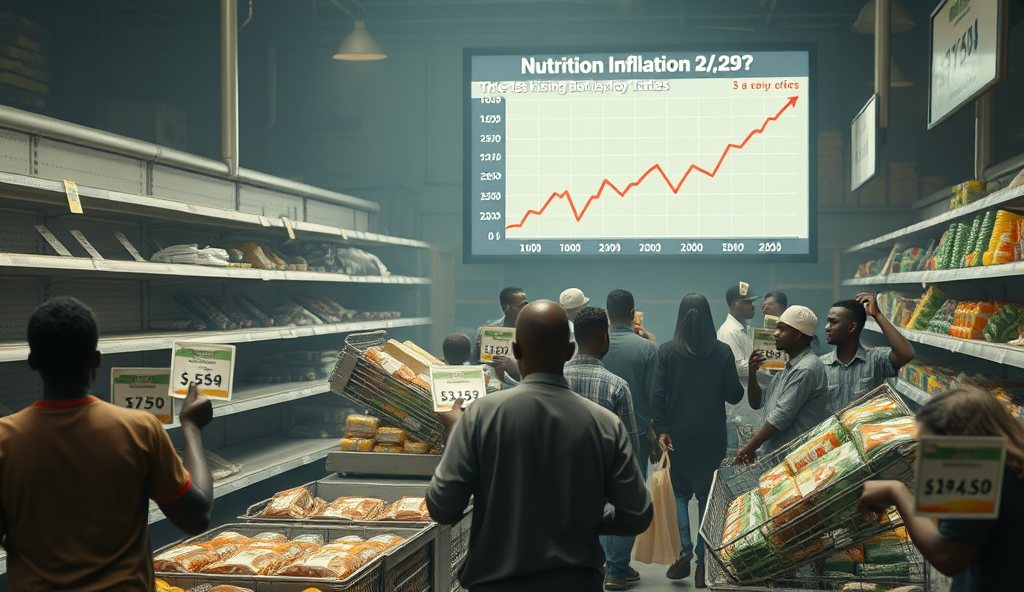Introduction: Understanding the Impact of Nutrition Inflation in Nigeria
Nutrition inflation in Nigeria has reached alarming levels, with food prices surging by over 30% in the past year alone, according to the National Bureau of Statistics. This sharp increase has forced many families to compromise on meal quality, leading to rising cases of malnutrition, particularly among children in low-income households.
The ripple effects extend beyond hunger, as inadequate nutrition weakens immune systems and reduces productivity, worsening Nigeria’s economic challenges. For instance, a recent UNICEF report revealed that 45% of Nigerian children under five suffer from stunted growth due to poor diets exacerbated by rising food prices.
As we examine the current state of food prices and nutrition in Nigeria, it becomes clear that urgent solutions are needed to help families maintain balanced diets despite inflation. The next section will delve deeper into the latest data on food affordability and its direct impact on household nutrition.
Key Statistics

The Current State of Food Prices and Nutrition in Nigeria
Nutrition inflation in Nigeria has reached alarming levels with food prices surging by over 30% in the past year alone according to the National Bureau of Statistics.
Recent data from the Nigeria Price Watch reveals staple foods like rice and beans now cost 40-60% more than 2022 prices, pushing balanced diets out of reach for 63% of households surveyed by the World Food Programme. This affordability crisis has shifted consumption patterns, with families increasingly relying on cheaper, less nutritious options like garri and processed noodles to stretch budgets.
The National Nutrition and Health Survey shows only 28% of Nigerian households now meet minimum dietary diversity standards, down from 42% pre-inflation, with protein sources becoming particularly scarce in daily meals. Urban markets report declining sales of eggs, fish, and lean meats as families prioritize quantity over quality, exacerbating micronutrient deficiencies across all age groups.
As food insecurity worsens, healthcare providers note rising admissions for nutrition-related conditions like kwashiorkor and anemia in children under five, creating an urgent need for affordable nutrient-rich alternatives. The following section will explore practical food substitutions that deliver essential vitamins and proteins without straining household budgets.
Affordable Nutrient-Rich Foods for Nigerian Families
Recent data from the Nigeria Price Watch reveals staple foods like rice and beans now cost 40-60% more than 2022 prices pushing balanced diets out of reach for 63% of households surveyed by the World Food Programme.
Despite rising food prices in Nigeria, nutrient-dense alternatives like moringa leaves, soybeans, and locally grown vegetables offer cost-effective solutions to combat malnutrition. A 2023 FAO report found these options provide comparable protein and micronutrients to expensive animal sources at 30-50% lower cost, making them viable for households facing food insecurity.
For protein needs, affordable options include unshelled groundnuts (40% cheaper than processed peanut butter) and dried catfish (retaining 90% of fresh fish nutrients at half the price). Nutritionists confirm these alternatives help address the protein scarcity highlighted in earlier surveys while fitting tight budgets.
Strategic use of seasonal produce like ugu, waterleaf, and sweet potatoes can boost dietary diversity without straining finances, creating a natural transition to creative meal planning approaches. These practical substitutions demonstrate how families can maintain nutrition despite inflation’s impact on Nigerian diets.
Creative Meal Planning on a Tight Budget
A 2023 FAO report found these options provide comparable protein and micronutrients to expensive animal sources at 30-50% lower cost making them viable for households facing food insecurity.
Building on Nigeria’s affordable protein and vegetable alternatives, families can maximize nutrition by repurposing ingredients across multiple meals. For example, a single batch of soybeans can be transformed into akara for breakfast, moi moi for lunch, and soy-enriched stew for dinner, stretching protein intake throughout the day.
Nutritionists note this approach reduces waste while meeting 70% of daily protein needs at half the cost of meat-based diets.
Batch cooking seasonal staples like yam or plantain with moringa-infused sauces ensures nutrient-rich meals for days without daily market trips. A Lagos-based study found households using this method saved 25% on weekly food expenses while maintaining balanced diets.
Combining dried catfish with ugu leaves in soups further enhances affordability without sacrificing essential vitamins or minerals.
Smart meal planning also involves leveraging leftovers creatively, such as turning leftover jollof rice into nutrient-packed fried rice with added vegetables. This strategy aligns with the next section’s focus on utilizing local and seasonal produce to combat food insecurity in Nigeria’s inflationary climate.
Utilizing Local and Seasonal Produce for Better Nutrition
Nigerian households lose an estimated 40% of purchased food to spoilage annually worsening food insecurity in Nigeria’s inflationary climate according to 2023 NBS data.
Prioritizing indigenous crops like okra, waterleaf, and local tomatoes during peak seasons can cut food costs by 30-40% while boosting nutrient intake, according to a 2023 FAO report on Nigerian food systems. Seasonal produce retains higher vitamin content and requires less preservation, making it ideal for families facing rising food prices in Nigeria’s inflationary climate.
Farmers’ markets in Ibadan and Enugu offer seasonal bundles of ugwu, telfairia, and bitter leaf at 50% lower prices than imported vegetables, providing affordable solutions for combating malnutrition. Nutritionists confirm these locally grown greens deliver comparable iron and folate levels to expensive imported alternatives when consumed at peak freshness.
This seasonal approach naturally complements the next strategy of reducing food waste, as properly stored local produce maintains quality longer while minimizing spoilage losses. Families can further stretch budgets by preserving surplus seasonal items through sun-drying or fermentation for later use.
Reducing Food Waste to Maximize Nutritional Value
Data from the National Bureau of Statistics reveals that 40% of Nigerian households now spend over 60% of their income on food making smart budgeting essential.
Nigerian households lose an estimated 40% of purchased food to spoilage annually, worsening food insecurity in Nigeria’s inflationary climate, according to 2023 NBS data. Simple techniques like storing root vegetables in breathable baskets and leafy greens in perforated bags can extend freshness by 3-5 days while preserving nutrient density.
Traditional preservation methods remain practical solutions for rising food prices in Nigeria, with sun-dried okra and fermented ogiri maintaining 80% of original protein content for months. Lagos-based nutritionists recommend portioning bulk purchases into weekly meal kits to prevent over-purchasing and ensure all seasonal produce gets consumed at peak nutritional value.
These waste-reduction strategies create natural synergies with community bulk buying approaches, as families pooling resources can access larger quantities of fresh produce at lower per-unit costs. Proper planning transforms surplus seasonal harvests into year-round nutrition buffers against Nigeria’s malnutrition and economic crisis.
Community Support and Bulk Buying Strategies
Neighborhood cooperatives in Lagos and Kano demonstrate how collective purchasing cuts food costs by 25-40%, with groups of 10-15 families securing wholesale prices on staples like rice, beans, and seasonal vegetables. These networks combine bulk savings with shared preservation knowledge, applying earlier discussed techniques like fermentation and proper storage to maximize value from larger quantities.
Farmers’ associations in Enugu and Oyo states now offer direct-to-community harvest boxes, delivering fresh produce at 30% below market rates while reducing spoilage through immediate distribution. Such initiatives align with nutritionists’ recommendations for portioned meal kits, ensuring families access diverse nutrients without individual over-purchasing risks prevalent in Nigeria’s inflationary climate.
These community models create scalable solutions that complement upcoming government interventions, proving localized action can mitigate food insecurity while awaiting broader policy changes. By pooling resources and knowledge, Nigerian households transform collective bargaining power into sustainable nutrition buffers against rising prices.
Government Policies and Their Role in Alleviating Nutrition Inflation
Building on community-led solutions, Nigeria’s National Agricultural Technology and Innovation Policy (NATIP) aims to boost food production by 40% by 2025 through subsidized inputs and extension services, directly addressing rising food prices in Nigeria. The recent removal of fuel subsidies has prompted compensatory measures like the conditional cash transfer program, targeting 15 million vulnerable households to cushion nutrition inflation impacts.
State governments are complementing federal efforts, with Lagos launching urban farming initiatives and Kano establishing grain reserves to stabilize staple prices during seasonal shortages. These interventions align with the earlier discussed community models, creating a multi-layered defense against food insecurity in Nigeria’s inflationary climate.
While policy implementation faces challenges, the synergy between government actions and grassroots efforts offers a framework for sustainable nutrition security. This sets the stage for empowering Nigerian families with comprehensive strategies to overcome nutrition inflation through combined systemic and localized solutions.
Conclusion: Empowering Nigerian Families to Overcome Nutrition Inflation
Despite rising food prices in Nigeria, families can still prioritize nutrition by applying the cost-saving strategies discussed earlier, such as bulk buying and seasonal meal planning. Local examples like the Lagos Food Bank initiative show how community efforts can supplement household nutrition during economic hardship.
Data from the National Bureau of Statistics reveals that 40% of Nigerian households now spend over 60% of their income on food, making smart budgeting essential. By focusing on affordable protein sources like beans and nutrient-dense local staples like unripe plantains, families can maintain balanced diets without overspending.
While government policies on food inflation in Nigeria remain inconsistent, grassroots solutions like cooperative farming and shared kitchen gardens offer immediate relief. These approaches not only address hunger but also foster community resilience against future economic shocks.
Frequently Asked Questions
What are the most affordable protein sources we can use instead of meat during this nutrition inflation?
Try unshelled groundnuts and dried catfish which provide comparable protein at half the cost of meat according to nutritionists.
How can we make our food budget stretch further without sacrificing nutrition?
Batch cook seasonal staples like yam with moringa sauce and repurpose ingredients across multiple meals to save 25% weekly.
Where can we find the cheapest fresh vegetables during this food price crisis?
Visit local farmers markets for seasonal bundles of ugwu and waterleaf which cost 50% less than imported vegetables.
What's the best way to store food to prevent waste and save money?
Use breathable baskets for root vegetables and perforated bags for leafy greens to extend freshness by 3-5 days.
How can we join community bulk buying groups to save on food costs?
Connect with neighborhood cooperatives in Lagos or Kano where 10-15 families pool resources for 25-40% wholesale discounts.


